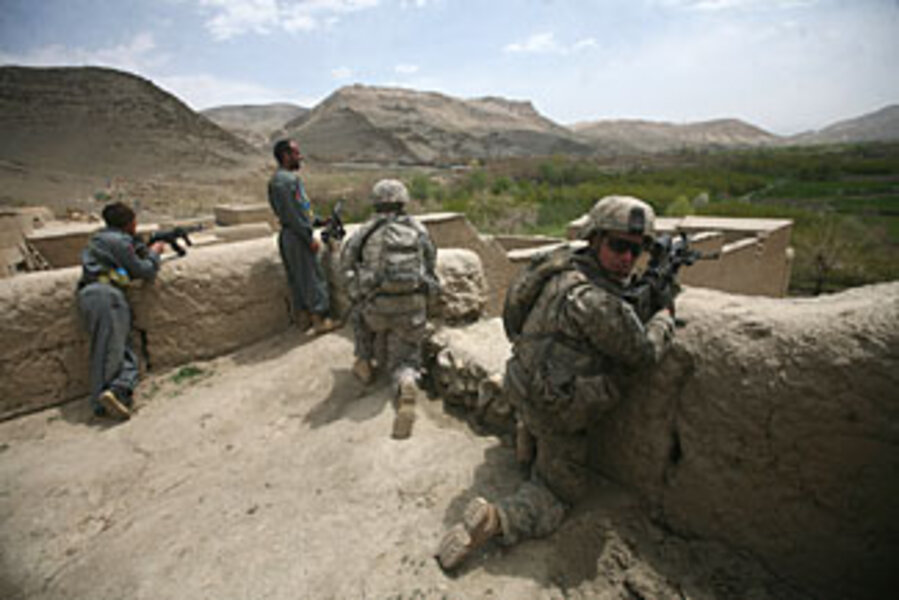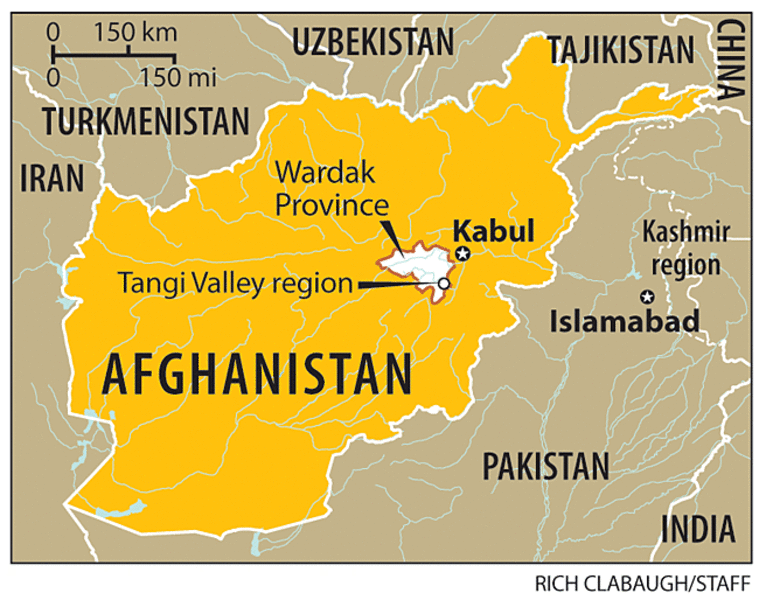In Afghanistan surge, soldiers negotiate complex web of local loyalties
Loading...
| Tangi Valley, Afghanistan
Part one of a two-part series.
When the soldiers of the 10th Mountain Division penetrated the insurgent-ridden Tangi Valley in the heart of Wardak Province, they braved rockets and roadside bombs. They succeeded in erecting a small outpost overlooking the lush, fertile dale in what is one of the most dangerous areas in the province.
Then they set about their main task: winning over the locals. They called a shura, or council, with the local elders here, to introduce themselves and take requests from the villagers.
"But to be honest, they didn't want us here," recalls 1st Lt. Christopher Wallgren, who commands the company of soldiers stationed in the Tangi, in eastern Afghanistan. "They all just asked us to leave. They didn't want us to interfere with their lives."
As thousands of US soldiers pour into Afghanistan this summer and push into uncharted territories, such an environment of mistrust will be one of the many challenges they will face in attempting to secure the country.
Early this year, nearly 1,500 troops landed in Wardak, which neighbors Kabul Province to the south, in a move that prefigured the larger influx this summer. Officials in Washington are hoping that the troop increase can reverse the growing insurgency. Adm. Michael Mullen, chairman of the Joint Chiefs of Staff, recently told reporters that the military buildup was "absolutely necessary" and that the new soldiers will have to force a dramatic turnaround in the security situation over the next 12 to 18 months.
In the areas where new forces landed this winter, violence has increased – just as officials in Washington predicted. In Wardak, the number of insurgent-initiated attacks so far this year has jumped by more than 300 percent from the same period last year, according to statistics provided by analyst Sami Kovanen of Tundra Security.
Convincing Afghans not an easy task
For the troops here in the Tangi, the key to a turnaround lies in convincing the locals that they are here to protect them. But the soldiers say that this has been difficult. While they are welcomed in some areas – in Jalrez district, for example, where the insurgency has weakened in the past year, children regularly greet soldiers with waves and smiles – they have had a different reception in other parts of the province.
On a typical vehicle patrol through the Tangi valley, which is part of Sayadabad district, soldiers closely watch the villagers who line the streets and stare at the passing convoy.
"Okay, we're heading into a bazaar," says one soldier over the radio to his comrades.
"Roger, heading into the bazaar. There's people all around," comes the reply from another vehicle in the convoy.
"These people out here don't like us, so keep your eyes open," the first soldier says.
Suddenly, a dull thud resounds in the vehicle. Then another. "They are throwing rocks at us!" shouts one soldier over the radio.
Children by the roadside scurry into the shops, while the adults avert their eyes.
Soldiers here recount instances when they have handed out candy to children, only to have it hurled back at them. When they recently killed a leading Taliban commander in the area named Mohebullah, a nearby town closed its bazaar for hours in remembrance of the fallen insurgent.
When they ask locals for information about insurgents operating in the area, they often get evasive answers or lies.
"I don't know why, but people there just don't seem to like us," says Pfc. Christopher Sues. "Maybe they are happy with the way they live."
In the absence of government, Taliban rules
According to locals, US intelligence officials, and analysts, the troops are facing local resistance for a variety of reasons.
"In Wardak, most of the insurgents are locals," says an American intelligence officer associated with the forces here, who spoke on the condition of anonymity.
"Every second or third house has a son or a brother in the Taliban," says Roshanak Wardak, a member of parliament from Sayadabad district of Wardak.
Even when locals don't support the insurgents, they are often reluctant to side with the troops out of fear of Taliban reprisals, she continues.
"Sometimes we'll meet some locals on a patrol and they will be very friendly," says Pfc. Jeremy Grimm. "But we'll come another day and those same people will be very cold to us – because someone is watching."
Over the years, the central government has been nonexistent in most of the province.
"The government sphere of influence is limited to Maydan Shahr [the provincial capital] and Jalrez [where the insurgency has weakened this year]," says the American intelligence officer. The Taliban has enjoyed a de facto control of such districts as Sayadabad, Chak, and Jaghatu for more than a year. During that time they established a parallel government, which dealt with local disputes and sometimes even collected taxes.
Some locals viewed this as the lesser of two evils when compared with the distant and corrupt Kabul administration.
In one recent shura held in Sayadabad district, elders asked the Americans to leave, saying that they were happy with Taliban rule, which limits crime, and complaining that the troops "cause the price of everything to increase," according to one participant of the meeting.
Insurgency limited by ethnic appeal
But such sentiments may not be universal, says Habibullah Rafeh, policy analyst with the Kabul Academy of Sciences.
"The Taliban's appeal is limited to their own ethnic group, and also has a strong tribal dimension," he says.
In some areas in the east, for example, there are anti-Taliban tribes that regularly cooperate with Western forces. Parts of Wardak made up of the Hazara minority, for example, are strongly in favor of the troops. And most in urban areas such as Kabul don't identify with the rurally based insurgents.
But here in Wardak, and in some of the places farther south where US troops will be heading this summer, the insurgents often share the same ethnicity, tribe, culture, and worldview as the communities in which they are embedded, says Mr. Rafeh.
• Tomorrow: The US strategy for gaining Afghan trust and winning the war.






